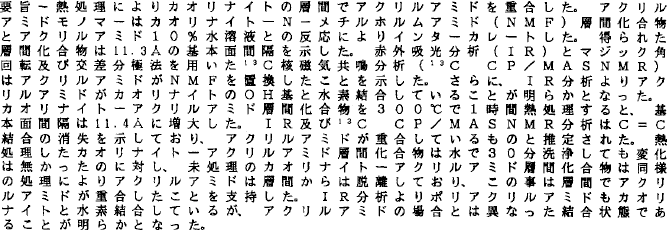Crossref Citations
This article has been cited by the following publications. This list is generated based on data provided by
Crossref.
Ogawa, Makoto
Nagafusa, Yasuyuki
Kuroda, Kazuyuki
and
Kato, Chuzo
1992.
Solid-state intercalation of acrylamide into smectites and Na-taeniolite.
Applied Clay Science,
Vol. 7,
Issue. 4,
p.
291.
Thompson, John G.
Uwins, Philippa J. R.
Whittaker, Andrew K.
and
Mackinnon, Ian D. R.
1992.
Structural Characterisation of Kaolinite:NaCl Intercalate and its Derivatives.
Clays and Clay Minerals,
Vol. 40,
Issue. 4,
p.
369.
Gao, Deyu
and
Heimann, Robert B.
1993.
Structure and mechanical properties of superabsorbent poly(acrylamide)-montmorillonite composite hydrogels.
Polymer Gels and Networks,
Vol. 1,
Issue. 4,
p.
225.
Goodman, B. A.
and
Chudek, J. A.
1994.
Clay Mineralogy: Spectroscopic and Chemical Determinative Methods.
p.
120.
Tunney, James J.
and
Detellier, Christian
1994.
Preparation and Characterization of Two Distinct Ethylene Glycol Derivatives of Kaolinite.
Clays and Clay Minerals,
Vol. 42,
Issue. 5,
p.
552.
Tunney, James J.
and
Detellier, Christian
1996.
Aluminosilicate Nanocomposite Materials. Poly(ethylene glycol)−Kaolinite Intercalates.
Chemistry of Materials,
Vol. 8,
Issue. 4,
p.
927.
Ukrainczyk, Ljerka
and
Smith, Karen Ann
1996.
Solid State 15N NMR Study of Pyridine Adsorption on Clay Minerals.
Environmental Science & Technology,
Vol. 30,
Issue. 11,
p.
3167.
Bantignies, Jean-Louis
Cartier dit Moulin, Christophe
and
Dexpert, Hervé
1997.
Wettability Contrasts in Kaolinite and Illite Clays: Characterization by Infrared and X-Ray Absorption Spectroscopies.
Clays and Clay Minerals,
Vol. 45,
Issue. 2,
p.
184.
Komori, Yoshihiko
Sugahara, Yoshiyuki
and
Kuroda, Kazuyuki
1998.
A kaolinite-NMF-methanol intercalation compound as a versatile intermediate for further intercalation reaction of kaolinite.
Journal of Materials Research,
Vol. 13,
Issue. 4,
p.
930.
Komori, Yoshihiko
Sugahara, Yoshiyuki
and
Kuroda, Kazuyuki
1999.
Direct Intercalation of Poly(vinylpyrrolidone) into Kaolinite by a Refined Guest Displacement Method.
Chemistry of Materials,
Vol. 11,
Issue. 1,
p.
3.
Gardolinski, José Eduardo
Peralta-Zamora, Patricio
and
Wypych, Fernando
1999.
Preparation and Characterization of a Kaolinite-1-methyl-2-Pyrrolidone Intercalation Compound.
Journal of Colloid and Interface Science,
Vol. 211,
Issue. 1,
p.
137.
Komori, Y
1999.
Intercalation of alkylamines and water into kaolinite with methanol kaolinite as an intermediate.
Applied Clay Science,
Vol. 15,
Issue. 1-2,
p.
241.
Carrado, K. A.
Xu, L.
Gregory, D. M.
Song, K.
Seifert, S.
and
Botto, R. E.
2000.
Crystallization of a Layered Silicate Clay as Monitored by Small-Angle X-ray Scattering and NMR.
Chemistry of Materials,
Vol. 12,
Issue. 10,
p.
3052.
Gardolinski, José Eduardo
Ramos, Luiz Pereira
de Souza, Gabriel Pinto
and
Wypych, Fernando
2000.
Intercalation of Benzamide into Kaolinite.
Journal of Colloid and Interface Science,
Vol. 221,
Issue. 2,
p.
284.
Matsumura, Asako
Komori, Yoshihiko
Itagaki, Tetsuro
Sugahara, Yoshiyuki
and
Kuroda, Kazuyuki
2001.
Preparation of a Kaolinite–Nylon 6 Intercalation Compound.
Bulletin of the Chemical Society of Japan,
Vol. 74,
Issue. 6,
p.
1153.
Deng, Youjun
White, G.Norman
and
Dixon, Joe B.
2002.
Effect of Structural Stress on the Intercalation Rate of Kaolinite.
Journal of Colloid and Interface Science,
Vol. 250,
Issue. 2,
p.
379.
Wang, Junzhong
Hu, Yuan
Li, Baoguang
Gui, Zhou
and
Chen, Zuyao
2004.
Preparation of polyacrylamide and gamma-zirconium phosphate nanocomposites by intercalative polymerization.
Ultrasonics Sonochemistry,
Vol. 11,
Issue. 5,
p.
301.
WYPYCH, FERNANDO
2004.
Clay Surfaces - Fundamentals and Applications.
Vol. 1,
Issue. ,
p.
1.
GRANDJEAN, JEAN
2004.
Clay Surfaces - Fundamentals and Applications.
Vol. 1,
Issue. ,
p.
216.
Onal, Y.
Yakıncı, E.
Seçkin, T.
and
Içduygu, M.G.
2005.
Synthesis and characterization of asbestos–silane hybrid materials.
Colloids and Surfaces A: Physicochemical and Engineering Aspects,
Vol. 255,
Issue. 1-3,
p.
27.
